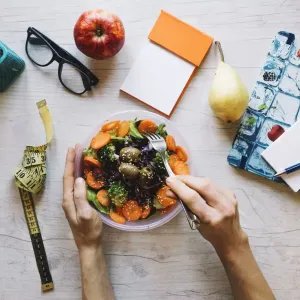

Our Review Process
Our articles undergo extensive medical review by board-certified practitioners to confirm that all factual inferences with respect to medical conditions, symptoms, treatments, and protocols are legitimate, canonical, and adhere to current guidelines and the latest discoveries. Read more.
Our Editorial Team
Shifa Fatima, MSc.
Author
Dr. Apoorva T, MHM.
MEDICAL ADVISOR
Table of Contents
Is Potato Good For Diabetes?
Potatoes are one of the most common vegetables in the human diet. In addition to being a rich source of carbohydrates, potatoes are also a good source of fiber, potassium, and vitamin B. If you are a person with diabetes, there is a good chance that you would have heard that potatoes should not be part of your diet, as they are high on carbohydrates. However, this is not the case. There are many misconceptions about what should and should not be part of a diet for people with diabetes. The present article will help clear some of these misconceptions concerning whether a person with diabetes can eat potatoes .Continue Reading If you want to know How do potatoes affect blood sugar?
How do Potatoes affect Blood Sugar Levels?
Potatoes are a rich source of carbohydrates. Carbohydrates are made up of sugar molecules. Is there glucose in potatoes, the enzymes in your body break these carbohydrates into a simple sugar called glucose that enters your blood circulation. The pancreas releases insulin hormone that facilitates glucose transport into the cells from the blood. However, in people with diabetes, the transportation of glucose into cells is inefficient, and therefore glucose remains in the blood, causing a spike in blood glucose levels. Therefore, potatoes are not recommended for people with diabetes.
What is the Carbohydrate Content in Potatoes?
An average-sized potato (weighing about 170 grams) consists of approximately 30 grams of carb, while the carb content in a large potato (weighing about 369 grams) is about 65 grams. The carb content of potatoes also varies across different methods of cooking. The carb content of half of ½ cup of potatoes (about 75-80 grams) cooked by other methods are as follows-
• Raw- 11.8 grams
• Baked- 13.1 grams
• Boiled- 15.7 grams
• Oven-baked fries- 17.8 grams
• Microwaved- 18.2 grams
• Deep-fried- 36.5 grams

Potato Glycemic Index
The Glycemic Index (GI) varies among potatoes and depends on their preparation. Potatoes are classified as having Medium (rating of 55-69) to High GI (rating of 70-100) foods. A baked potato has a GI value of 111, whereas a boiled potato has 82.
Similarly, the Glycemic Load (GL) also tends to vary among different varieties of potatoes. As a reference, the Glycemic Load of 1 cup (about 150 grams) of different varieties of potatoes is classified into low GL, medium GL, and high GL as follows-
- High GL (20 and above)- Mashed
- Medium GL (11-19)- Boiled
- Low GL (10 and under)- Cooked and cooled

How to Lower the GI and GL of a Potato?
The method through which potatoes are cooked has a significant impact on the GI and GL values, as the structure of starch gets altered during cooking. This affects the rate at which they are absorbed into the blood. Generally, the GI value of a potato tends to increase with an increase in cooking time. Following cooking, cooling the potatoes increases the content of resistant starch (a less digestible form of carb), reducing the GI by 25-28%. Therefore, it is better to have potato salads rather than French fries. Another great way of lowering the GI and GL of a potato is by leaving the potatoes skins for extra fiber and eating a mixed meal with fat and protein. Read on to know can sugar patient eat potato?
Risks of Eating Potatoes
Though it is safe to eat potatoes, the type and amount of potatoes one eats can have profound implications on one's health. Eating too many potatoes can accelerate the risk of type 2 diabetes mellitus and negatively impact existing diabetes patients. Potato chips and other fried potatoes contain a significant amount of unhealthy fats that may lower high-density lipoprotein (HDL) cholesterol (good cholesterol), increase blood pressure, and lead to obesity. Moreover, potatoes should also be avoided with rice or bread as all these are high in carbs. These factors increase the risks of heart disease.
Furthermore, fried potatoes are also high in calories, which can cause weight gain. Diabetes patients are expected to maintain a healthy weight or lose unwanted weight to cope with elevated blood sugar and minimize complications. Therefore, it is best to avoid potato chips, french fries, and potato dishes that can contain numerous fats.
Good Replacements for Potatoes
Though it is acceptable to consume potatoes if you have diabetes, limiting their consumption and replacing them with other healthier options would be great. Following are some low GI and GL foods that are high on fiber and low on carb-
- Sweet potato: These tubers have a lower GI when compared with white potatoes. Additionally, they are a rich source of vitamin A. However, they are still high in carbs and should not be loaded onto the plate.
- Taro: The roots are low in carbs, and the GL is about 4. They can serve as an alternative to potato chips.
- Cauliflower: This veggie is low on carb and can serve as an alternative to potatoes. They are either boiled, baked, or steamed.
- Carrots: Carrots have low GI and GL and can be prepared either steamed, boiled, or baked.
- Pumpkin and squash: These are suitable replacements for mashed and baked potatoes. They are low on carbs and have low GI and GL.
- Legumes and lentils: These foods are high in carbs, though they have low GL. They are rich in fiber, and care should be taken not to consume them in large quantities, as they can elevate blood glucose levels.
Bottomline
Potatoes are high in carbs and can therefore elevate blood glucose levels. Consuming too many potatoes can negatively affect people with diabetes and accelerate heart diseases. However, they are rich in fiber, minerals, and vitamins, and they can be consumed as part of a healthy balanced diet. Cooking potatoes, either steamed or baked and eating them with other non-starchy foods, can reduce the GI and GL values.
References
- https://www.medicalnewstoday.com/articles/323449
Disclaimer
This website's content is provided only for educational reasons and is not meant to be a replacement for professional medical advice. Due to individual differences, the reader should contact their physician to decide whether the material is applicable to their case.








